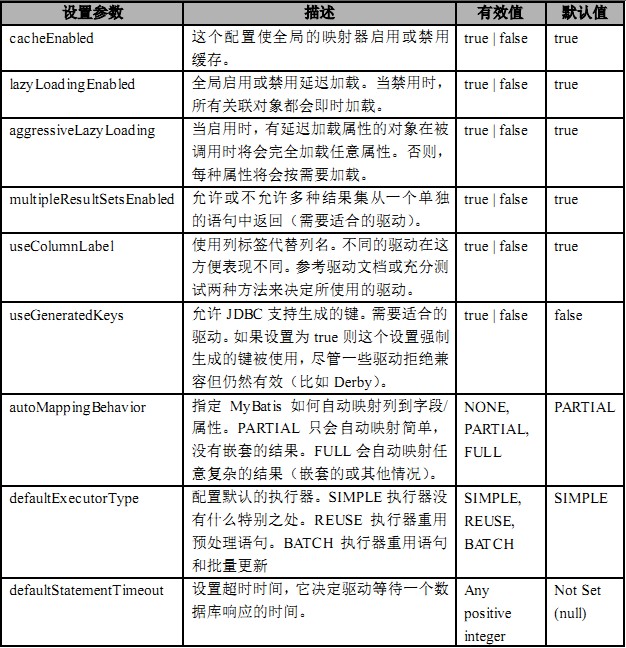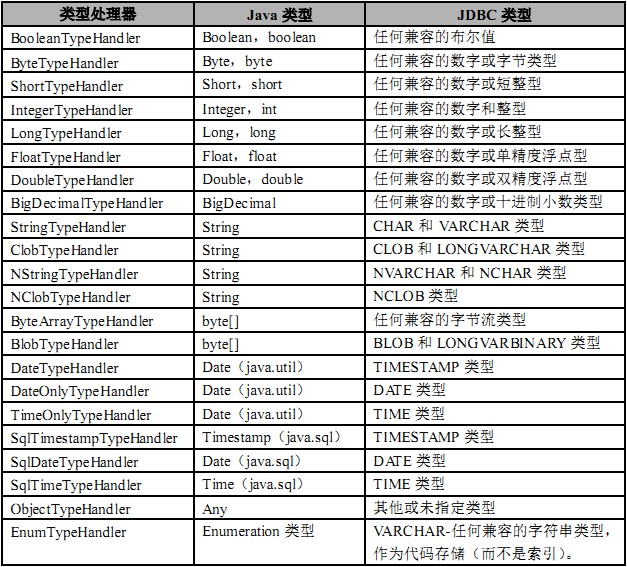<!-- й…ҚзҪ®ҫlҷе®ҡе‘ҪеҗҚҪIәй—ҙзҡ„зј“еӯ?-->
<cache></cache>
<!-- д»Һе…¶д»–е‘ҪеҗҚз©әй—ҙеј•з”Ёзј“еӯҳй…Қҫ|?-->
<cache-ref namespace="" />
<!-- жҸҸиҝ°еҰӮдҪ•һ®ҶdbдёӯжҹҘиҜўзҡ„ҫl“жһңйӣҶеҠ иҪҪжҲҗеҜ№иұЎ -->
<resultMap type="" id="">
<constructor>
<idArg />
<arg />
<arg />
<arg />
</constructor>
</resultMap>
<!-- е®ҡд№үеҸҜйҮҚз”Ёзҡ„sqlиҜӯеҸҘ -->
<sql id=""></sql>
<!-- жҳ е°„dmlиҜӯеҸҘ -->
<insert id=""></insert>
<select id=""></select>
<update id=""></update>
<delete id=""></delete>
дёҖгҖҒselectеҸҜд»ҘеҸҜд»ҘиҜҙжҳҜдҪҝз”ЁжңҖеӨҡзҡ„е…ғзҙ еQҢдӢЙз”Ёд№ҹеҫҲз®ҖеҚ?/p>
- <select id="getUserById" parameterType="int" resultType="User">
- select * from tbl_user where id = #{id}
- </select>
< select>е…ғзҙ дёӯзҡ„дёҖдәӣеұһжҖ?ҫUўиүІдёәз”Ёзҡ„иҫғеӨҡзҡ„еұһжҖ?
| id | еңЁе‘ҪеҗҚз©әй—ҙдёӯе”ҜдёҖзҡ„ж ҮиҜҶз¬ҰеQҢеҸҜд»Ҙиў«з”ЁжқҘеј•з”ЁҳqҷжқЎиҜӯеҸҘ |
| parameterType | һ®Ҷдјҡ(xЁ¬)дј е…ҘҳqҷжқЎиҜӯеҸҘзҡ„еҸӮж•°зұ»зҡ„е®Ңе…Ёйҷҗе®ҡеҗҚжҲ–еҲ«еҗҚгҖ?/td> |
| resultType | д»ҺиҝҷжқЎиҜӯеҸҘдёӯҳq”еӣһзҡ„жңҹжңӣзұ»еһӢзҡ„ҫcИқҡ„е®Ңе…Ёйҷҗе®ҡеҗҚжҲ–еҲ«еҗҚгҖ?br />ж„ҸйӣҶеҗҲжғ…еҪўпјҢйӮЈеә”иҜҘжҳҜйӣҶеҗҲеҸҜд»ҘеҢ…еҗ«зҡ„зұ»еһӢпјҢ иҖҢдёҚиғҪжҳҜйӣҶеҗҲжң¬инnгҖӮдӢЙз”?resultTypeжҲ?resultMapеQ?br />дҪҶдёҚиғҪеҗҢж—¶дӢЙз”?/span>гҖӮпјҲеҸҜд»ҘжҳҜеҹәжң¬зұ»еһӢintҪ{үпјҢ еӨҚеҗҲҫcХdһӢUserеQҢйӣҶеҗҲзұ»еһӢmap,listҪ{үпјү(jЁӘ) |
| resultMap | е‘ҪеҗҚеј•з”ЁеӨ–йғЁзҡ„resultMapгҖӮиҝ”еӣһmapжҳҜMyBat is жңҖе…·еҠӣйҮҸзҡ„зүТҺ(guЁ©)Җ§пјҢеҜ№е…¶жңүдёҖдёӘеҫҲеҘҪзҡ„зҗҶи§Јзҡ„иҜқеQ?br />еӨҡеӨҚжқӮжҳ һ®„зҡ„жғ…еЕһһ®ЮpғҪиў«и§ЈеҶідәҶ(jiЁЈn)гҖ?br />дҪҝз”Ё resultMap жҲ–resultTypeеQҢдҪҶдёҚиғҪеҗҢж—¶дҪҝз”ЁгҖ?/td> |
| flushCache | һ®Ҷе…¶и®„ЎҪ®дё?trueеQҢдёҚи®шҷҜӯеҸҘд»Җд№Ҳж—¶еҖҷиў«еёҰе“Ұз”ЁпјҢ йғҪдјҡ(xЁ¬)еҜЖDҮҙҫ~“еӯҳиў«жё…ҪIәгҖӮй»ҳи®ӨеҖы|јҡ(xЁ¬)false |
| useCache | һ®Ҷе…¶и®„ЎҪ®дё?trueеQҢе°Ҷдј?xЁ¬)еҜјиҮҙжң¬жқЎиҜӯеҸҘзҡ„ҫl“жһңиў«зј“еӯҳгҖ?br />й»ҳи®ӨеҖы|јҡ(xЁ¬)true |
| timeout | ҳqҷдёӘи®„ЎҪ®й©ұеҠЁҪEӢеәҸҪ{үеҫ…ж•°жҚ®еә“иҝ”еӣһиҜ·жұӮз»“жһңпјҢтq¶жҠӣеҮ?br />ејӮеёёж—үҷ—ҙзҡ„жңҖеӨ§зӯүеҫ…еҖ№{ҖӮй»ҳи®ӨдёҚи®„ЎҪ®еQҲй©ұеҠЁиҮӘиЎҢеӨ„зҗҶпјү(jЁӘ) |
| fetchSize | ҳqҷжҳҜжҡ—зӨәй©ұеҠЁҪEӢеәҸжҜҸж¬ЎжүҡwҮҸҳq”еӣһзҡ„з»“жһңиЎҢж•°гҖ?br />й»ҳи®ӨдёҚи®ҫҫ|®пјҲй©ұеҠЁиҮӘиЎҢеӨ„зҗҶеQ?/td> |
| statementType | STATEMENT,PREPARED жҲ?CALLABLE зҡ„дёҖҝUҚгҖ?br />ҳqҷдјҡ(xЁ¬)и®?MyBat isдҪҝз”ЁйҖүжӢ©дҪҝз”Ё StatementеQҢPreparedStatementжҲ?CallableStatementгҖ?br />й»ҳи®ӨеҖы|јҡ(xЁ¬)PREPAREDгҖ?/td> |
| resultSetType | FORWARD_ONLYеQ?br />SCROLL_SENSITIVEеQ?br />SCROLL_INSENSITIVEдёӯзҡ„дёҖҝUҚгҖ?br />й»ҳи®ӨжҳҜдёҚи®„ЎҪ®еQҲй©ұеҠЁиҮӘиЎҢеӨ„зҗҶпјү(jЁӘ) |
дәҢгҖҒinsertжҸ’е…Ҙж•°жҚ®еә“пјҢҳqӣиЎҢжҸ’е…Ҙж“ҚдҪңж—¶дё»иҰҒжҳҜиҰҒжӢҝеҲ°жҸ’е…Ҙж•°жҚ®иҮӘеўһзҡ„дё»й”®
| id | еңЁе‘ҪеҗҚз©әй—ҙдёӯе”ҜдёҖзҡ„ж ҮиҜҶз¬ҰеQҢеҸҜд»Ҙиў«з”ЁжқҘеј•з”ЁҳqҷжқЎиҜӯеҸҘгҖ?/td> |
| parameterType | һ®Ҷдјҡ(xЁ¬)дј е…ҘҳqҷжқЎиҜӯеҸҘзҡ„еҸӮж•°зұ»зҡ„е®Ңе…Ёйҷҗе®ҡеҗҚжҲ–еҲ«еҗ?/td> |
| flushCache | һ®Ҷе…¶и®„ЎҪ®дё?trueеQҢдёҚи®шҷҜӯеҸҘд»Җд№Ҳж—¶еҖҷиў«еёҰе“Ұз”ЁпјҢйғҪдјҡ(xЁ¬)еҜЖDҮҙҫ~“еӯҳиў«жё…ҪIәгҖӮй»ҳи®ӨеҖы|јҡ(xЁ¬)falseгҖ?/td> |
| timeout | ҳqҷдёӘи®„ЎҪ®й©ұеҠЁҪEӢеәҸҪ{үеҫ…ж•°жҚ®еә“иҝ”еӣһиҜ·жұӮз»“жһңпјҢтq¶жҠӣеҮәејӮеёёж—¶й—ҙзҡ„жңҖеӨ§зӯүеҫ…еҖ№{Җ?br />й»ҳи®ӨдёҚи®ҫҫ|®пјҲй©ұеҠЁиҮӘиЎҢеӨ„зҗҶеQүгҖ? |
| statementType | STATEMENT,PREPARED жҲ?CALLABLE зҡ„дёҖҝUҚгҖӮиҝҷдј?xЁ¬)и®?MyBat isдҪҝз”ЁйҖүжӢ©дҪҝз”Ё StatementеQҢPreparedStatement жҲ?CallableStatementгҖӮй»ҳи®ӨеҖы|јҡ(xЁ¬)PREPAREDгҖ? |
| useGeneratedKeys | еQ?span style="color: rgb(255, 0, 0);">д»…еҜ№ insert жң?з”?/span> еQ?ҳq?дј?е‘?иҜ?MyBat is дҪҝз”Ё JDBC зҡ„getGeneratedKeys ж–ТҺ(guЁ©)і•жқҘеҸ–еҮәз”ұж•°жҚ®еQҲжҜ”еҰӮпјҡ(xЁ¬)еғ?MySQL е’?SQL Server ҳqҷж ·зҡ„ж•°жҚ®еә“ҪҺЎзҗҶҫpИқ»ҹзҡ„иҮӘеҠЁйҖ’еўһеӯ—ж®өеQүеҶ…йғЁз”ҹжҲҗзҡ„дё»й”®гҖӮй»ҳи®ӨеҖы|јҡ(xЁ¬)falseгҖ?/td> |
| keyProperty | еQ?span style="color: rgb(255, 0, 0);">д»…еҜ№insertжңүз”ЁеQ?ж Үи®°дёҖдёӘеұһжҖ§пјҢ MyBat isдј?xЁ¬)йҖҡиҝҮgetGeneratedKeysжҲ–иҖ…йҖҡиҝҮ insert иҜӯеҸҘзҡ„selectKey еӯҗе…ғзҙ и®ҫҫ|®е®ғзҡ„еҖ№{ҖӮй»ҳи®Өпјҡ(xЁ¬)дёҚи®ҫҫ|®гҖ?/td> |
еңЁиҝӣиЎҢinsertеQҢupdate,deleteд№ӢеҗҺsessionиҰҒиҝӣиЎҢcommitж“ҚдҪңеQҢдёҚ然数жҚ®еә“дёҚдјҡ(xЁ¬)жӣҙж–°еҲ°ж•°жҚ®еә“
insertзҡ„Demo
еҸҰдёҖҝUҚиҺ·еҸ–дё»й”®зҡ„ж–ТҺ(guЁ©)і•
- <insert id="addUserLastId" parameterType="User">
- <selectKey resultType="int" order="AFTER" keyProperty="id">
- SELECT LAST_INSERT_ID() AS id
- </selectKey>
- insert into tbl_user(name,age) values(#{name},#{age})
- </insert>
- <insert id="addUser" parameterType="User" keyProperty="id" useGeneratedKeys="true" >
- insert into tbl_user(name,age) values(#{name},#{age})
- </insert>
- @Test
- public void testInsert() throws IOException {
- UserMapper mapper = session.getMapper(UserMapper.class) ;
- User user = new User() ;
- user.setName("zhangss") ;
- user.setAge(22) ;
- int i = mapper.addUser(user) ;
- session.commit() ;
- session.close() ;
- System.out.println("id:"+i+"--"+user.getId());
- }
updateзҡ„Demo
- <update id="updateUser" parameterType="User">
- update tbl_user set name = #{name} ,age = #{age} where id = #{id}
- </update>
- @Test
- public void testUpdate(){
- UserMapper mapper = session.getMapper(UserMapper.class) ;
- User user = new User() ;
- user.setId(27) ;
- user.setName("zhang27") ;
- user.setAge(227) ;
- int i = mapper.updateUser(user) ;
- session.commit() ;
- session.close() ;
- System.out.println("id:"+i+"--"+user.getId());
- }
дёүгҖҒsqlе®ҡд№үеҸҜйҮҚз”Ёзҡ„sqlиҜӯеҸҘ
- <sql id="selectItem">id,name,age</sql>
- <select id="getUserById" parameterType="int" resultType="User">
- <!--
- select * from tbl_user where id = #{id}
- -->
- select <include refid="selectItem"/> from tbl_user where id = #{id}
- </select>
#{department, mode=OUT, jdbcType=CURSOR, javaType=ResultSet,resultMap=departmentResultMap}
дә”гҖҒresultMapжүҖеҒҡзҡ„е·ҘдҪңһ®ұжҳҜһ®Ҷд»Һж•°жҚ®еә“дёӯиҺ·еҸ–зҡ„ResultSetҫl“жһңйӣҶж”ҫе…ҘжҢҮе®ҡзҡ„еҜ№иұЎдёӯпјҢйҒҝе…ҚеӨ§йҮҸзҡ„setter getterд»Јз ҒеQҢе®һзҺ°иҮӘеҠЁиЈ…й…Қзҡ„еҠҹиғҪеQҢе®һзҺ°з»“жһңзҡ„жҳ е°„
1гҖҒз®ҖеҚ•жҳ һ®?/p>
- <select id=”selectUsers” parameterType=”int” resultType=”hashmap”>
- select id, username, hashedPassword from some_table where id = #{id}
- </select>
жүҖжңүеҲ—иў«иҮӘеҠЁжҳ һ®„еҲ° HashMap зҡ„й”®дёҠпјҢkeyдёәеҲ—еҗҚпјҢvalueдёәж•°жҚ®еә“дёӯзҡ„ж•°жҚ®
- <select id=”selectUsers” parameterType=”int” resultType=”com.someapp.model.User”>
- select id, username, hashedPassword from some_table where id = #{id}
- </select>
һ®ҶжүҖжңүд»Һж•°жҚ®еә“дёӯеҸ–еҫ—ж•°жҚ®иҮӘеҠЁиЈ…й…ҚеҲ°JavaBeanдёӯпјҢеҰӮжһңеҲ—еҗҚдёҺеұһжҖ§еҗҚзӣёеҗҢеQҢеҲҷж— йңҖдҪңд“QеҠЎзҡ„тqІйў„еҚӣ_ҸҜе®ҢжҲҗиЈ…й…ҚгҖ?p>
еҰӮжһңж•°жҚ®еә“дёӯзҡ„еҲ—еҗҚдёҺjavabeanзҡ„еұһжҖ§еҗҚҝUоCёҚеҗҢеҸҜд»ҘеңЁжҹҘиҜўзҡ„ж—¶еҖҷеҸ–еҲ«еҗҚеQҢеҰӮ
- <select id=”selectUsers” parameterType=”int” resultType=”User”>
- select user_id as “id”, user_name as “userName”, hashed_password as “hashedPassword” from some_table where id = #{id}
- </select>
д№ҹеҸҜд»ҘдӢЙз”ЁresultMapҳqӣиЎҢжҳ е°„зҡ„жҢҮе®?p>
- <resultMap id="userResultMap" type="User">
- <id property="id" column="user_id" />
- <result property="username" column="username"/>
- <result property="password" column="password"/>
- </resultMap>
- <select id=”selectUsers” parameterType=”int” resultMap=”userResultMap”>
- select user_id, user_name, hashed_password from some_table where id = #{id}
- </select>
2гҖҒresultMapй«ҳзс”жҳ е°„
еңәжҷҜҳqҗиЎҢдёҚеҗҢзҡ„й…Қҫ|®зӯүҪ{үгҖ?/p>
дёҖгҖҒConfiguration.xmlдёӯеҸҜд»Ҙй…Қҫ|®зҡ„жүҖжңүеҶ…е®?/p>
| configuration й…ҚзҪ® | |||
| properties еұһжҖ?/td> | |||
| settings и®„ЎҪ® | |||
| typeAliases ҫcХdһӢе‘ҪеҗҚ | |||
| typeHandlers ҫcХdһӢеӨ„зҗҶеҷ? | |||
| objectFactory еҜ№иұЎе·ҘеҺӮ | |||
| plugins жҸ’дҡg | |||
| environments зҺҜеўғ | |||
| environment зҺҜеўғеҸҳйҮҸ | |||
| transactionManager дәӢеҠЎҪҺЎзҗҶеҷ? | |||
| dataSource ж•°жҚ®жә? | |||
| жҳ е°„еҷ?/span> |
дәҢгҖҒPropertiesж Үзӯҫ
еҸҜд»Ҙз”ЁжқҘеј•з”ЁеӨ–йғЁзҡ„еұһжҖ§ж–Ү件иҝӣиЎҢй…Қҫ|®пјҢжҜ”еҰӮжүҖжңүзҡ„й…ҚзҪ®йғҪеңЁдёҖдёӘeas.propertiesдёӯй…Қҫ|®пјҢеҸӘйңҖиҰҒеңЁpropertiesдёӯй…Қҫ|®дёҖӢЖЎпјҢһ®ұеҸҜд»ҘеҒҡеҲоCёҖӢЖЎй…Қҫ|®еҲ°еӨ„еј•з”ЁгҖ?/p>
еҰӮзҺ°еңЁй…Қҫ|®дёҖдёӘeas.properties
- #db config
- db.driver:com.sybase.jdbc3.jdbc.SybDriver
- db.url:jdbc:sybase:Tds:192.168.2.143:2678/SMM_win2k8_portal
- db.username:dba
- db.password:smmsql
- #server config
- server.url:http://192.168.2.101:8080/EAS
еңЁconfiguration.xmlдёӯеҜ№еұһжҖ§ж–Ү件дёӯзҡ„еҖЖDҝӣиЎҢеј•з”?p>
- <?xml version="1.0" encoding="UTF-8"?>
- <!DOCTYPE configuration PUBLIC "-//mybatis.org//DTD Config 3.0//EN"
- "http://mybatis.org/dtd/mybatis-3-config.dtd">
- <configuration>
- <properties resource="eas.properties" />
- <environments default="development">
- <environment id="development">
- <transactionManager type="JDBC"/>
- <dataSource type="POOLED">
- <property name="driver" value="${db.driver}"/>
- <property name="url" value="${db.url}"/>
- <property name="username" value="${db.username}"/>
- <property name="password" value="${db.password}"/>
- </dataSource>
- </environment>
- </environments>
- </configuration>
дёүгҖҒSetteingж ҮзӯҫеQҢеҜ№mybatisзҡ„дёҖдәӣиЎҢдёшҷҝӣиЎҢи®ҫҫ|?/p>

й…ҚзҪ®
<settings>
<setting name="cacheEnabled" value="true"/>
<setting name="lazyLoadingEnabled" value="true"/>
<setting name="multipleResultSetsEnabled" value="true"/>
<setting name="useColumnLabel" value="true"/>
<setting name="useGeneratedKeys" value="false"/>
<setting name="enhancementEnabled" value="false"/>
<setting name="defaultExecutorType" value="SIMPLE"/>
<setting name="defaultStatementTimeout" value="25000"/>
< /settings>
еӣӣгҖҒtypeAliases дёЮZёҖҫc»и®ҫҫ|®еҲ«еҗҚпјҢж–№дҫҝд№ҰеҶҷ
- <typeAliases>
- <!-- simple alias for full class name -->
- <typeAlias alias="App" type="com.justsy.eas.domain.App"/>
- <typeAlias alias="Content" type="com.justsy.eas.domain.Content"/>
- <typeAlias alias="AppDevice" type="com.justsy.eas.domain.AppDevice"/>
- <typeAlias alias="ListApp" type="com.justsy.eas.http.domain.ListApp"/>
- <typeAlias alias="ClientApp" type="com.justsy.eas.http.domain.ClientApp"/>
- </typeAliases>
java дёӯдёҖдәӣз®ҖеҚ•зұ»еһӢзҡ„еҲ«еҗҚ
еҲ«еҗҚ жҳ е°„зҡ„зұ»еһ?
_byte byte
_long long
_short short
_int int
_integer int
_double double
_float float
_boolean boolean
string String
byte Byte
long Long
short Short
int Integer
integer Integer
double Double
float Float
boolean Boolean
date Date
decimal BigDecimal
bigdecimal BigDecimal
object Object
map Map
hashmap HashMap
list List
arraylist ArrayList
collection Collection
iterator Iterator
дә”гҖҒtypeHandlers зҡ„дҪңз”ЁжҳҜһ®ҶJavaҫcХdһӢдёҺж•°жҚ®еә“дёӯзұ»еһӢиҝӣиЎҢеҢ№й…ҚпјҢеңЁstatementи®‘ЦҖје’ҢResultSetӢӮҖ(gЁЁ)зҙўеҖјж—¶еҸҜд»ҘжӯЈзЎ®зҡ„иқ{жҚўпјҢеҸҜд»Ҙе®һзҺ°TypeHandlerжҺҘеҸЈе®һзҺ°иҮӘе·ұзҡ„зұ»еһӢеӨ„зҗҶеҷЁгҖӮmybatisдёӯеҶ…е»әзҡ„ҫcХdһӢеӨ„зҗҶеҷ?Type Handler )

е…ӯгҖҒObjectFactory жҜҸж¬ЎеҲӣеҫҸж–°зҡ„ҫl“жһңеҜ№иұЎжҳҜи°ғз”ЁиҝҷдёӘObjectFactoryзҡ„еҜ№иұЎжқҘҳqӣиЎҢеҲӣеҫҸеQҢе®ғдј?xЁ¬)жҜ”зӣҙжҺҘи°ғз”Ёжһ„йҖ еҮҪж•°еҲӣе»әеҜ№иұЎеҒҡжӣҙеӨҡзҡ„е·ҘдҪ?/p>
дёғгҖҒpluginsдё»иҰҒз”ЁжқҘе®һзҺ°жӢҰжҲӘеҷЁзҡ„еҠҹиғҪеQҢдӢЙз”ЁеҲ°дә?jiЁЈn)еҠЁжҖҒд»ЈзҗҶпјҢеҸҜд»ҘжҢҮе®ҡеңЁжҹҗдәӣж“ҚдҪңж—¶жү§иЎҢдёҖдәӣжӢҰжҲӘж“ҚдҪңпјҢжҜ”еҰӮеңЁдёҖжқЎи®°еҪ•жҸ’е…Ҙж•°жҚ®еә“д№ӢеүҚеҶҷе…ҘдёҖжқЎж—Ҙеҝ—пјҢжҲ–жҹҘиҜўдёҖдё?/p>
жқғйҷҗҪ{үзӯү
пҒ?nbsp; Executor
(update, query, flushStatements, commit, rollback, getTransaction, close, isClosed)
пҒ?nbsp; ParameterHandler
(getParameterObject, setParameters)
пҒ?nbsp; ResultSetHandler
(handleResultSets, handleOutputParameters)
пҒ?nbsp; StatementHandler
(prepare, parameterize, batch, update, query)
- // ExamplePlugin.java
- @Intercepts({ @Signature(type = Executor.class, method = "update", args = { MappedStatement.class, Object.class }) })
- public class ExamplePlugin implements Interceptor {
- public Object intercept(Invocation invocation) throws Throwable {
- return invocation.proceed();
- }
- public Object plugin(Object target) {
- return Plugin.wrap(target, this);
- }
- public void setProperties(Properties properties) {
- }
- }
- <plugins>
- <plugin interceptor="org.mybatis.example.ExamplePlugin">
- <property name="someProperty" value="100"/>
- </plugin>
- </plugins>
һ®Чғјҡ(xЁ¬)еңЁжүҖжңүжү§иЎҢupdateеҠЁдҪңд№ӢеүҚҳqӣиЎҢжӢҰжҲӘеQҢжү§иЎҢExamplePluginдёӯиҮӘе®ҡд№үзҡ„дёҖдәӣйҖ»иҫ‘
еҜ№selectҳqӣиЎҢжӢҰжҲӘзҡ„plugin
- import org.apache.ibatis.session.ResultHandler;
- import org.apache.ibatis.session.RowBounds;
- @Intercepts({ @Signature(args = { MappedStatement.class, Object.class, RowBounds.class, ResultHandler.class }, method = "query", type = Executor.class) })
- public class LogInterceptor implements Interceptor {
- int index;
- @Override
- public Object intercept(Invocation invocation) throws Throwable {
- System.out.println("some log!!!");
- return invocation.proceed();
- }
- @Override
- public Object plugin(Object target) {
- System.out.println("1223--------------" + (index++));
- return Plugin.wrap(target, this);
- }
- @Override
- public void setProperties(Properties properties) {
- }
- }
- <plugins>
- <plugin interceptor="com.akwolf.interceptor.LogInterceptor">
- </plugin>
- </plugins>
е…«гҖҒenvironments еҜ№дәҺдёҖдёӘеә”з”ЁеҸҜиғҪиҝһжҺҘеӨҡдёӘж•°жҚ®еә“еQҢйӮЈһ®ұйңҖиҰҒй…Қҫ|®дёҚеҗҢзҡ„зҺҜеўғжқҘиҝһжҺҘдёҚеҗҢзҡ„ж•°жҚ®еә“пјҢжҜҸдёҖдёӘSqlSessionFactoryеҜ№еә”дёҖдёӘenvironments
д№ҹеҸҜд»Ҙи®ҫҫ|®дёҚеҗҢзҡ„зҺҜеўғеә”з”ЁдәҺејҖеҸ‘жҲ–Ӣ№ӢиҜ•зҡ„зҺҜеў?/p>
еҰӮжһңзҺҜеўғиў«еҝҪз•ҘпјҢйӮЈд№Ҳй»ҳи®ӨзҺҜеўғ?yЁӯu)®Ҷдј?xЁ¬)иў«еҠ иҪҪпјҢд№ҹе°ұжҳҜdefault="development"зҡ„дҪңз”ЁдәҶ(jiЁЈn)
д№?jiЁҰ)гҖҒtransactionManagerи®„ЎҪ®дәӢзү©зҡ„з®ЎзҗҶзұ»еһӢжҳҜ type=”[JDBC|MANAGED]”
JDBCдҪҝз”Ёdatasourceзҡ„иҝһжҺҘжқҘҪҺЎзҗҶдәӢзү©иҢғеӣҙгҖ?/p>
MANAGEDиҮӘе·ұдёҚиҝӣиЎҢдәӢзү©зҡ„жҸҗдәӨе’Ңеӣһж»ҡпјҢдҫқйқ е®№еҷЁжқҘз®ЎзҗҶдәӢзү©пјҢи®„ЎҪ®closeConnectionдёәfalseеQҢеҸ–ж¶ҲиҮӘеҠЁе…ій—ӯиҝһжҺ?/p>
- <transactionManager type="MANAGED">
- <property name="closeConnection" value="false"/>
- </transactionManager>
еҚҒгҖҒdataSourceи®„ЎҪ®ж•°жҚ®жәҗ[UNPOOLED|POOLED|JNDI]
POOLED:жҜҸж¬Ўиў«иҜ·жұӮж—¶ҪҺҖеҚ•жү“ејҖе’Ңе…ій—ӯиҝһжҺ?br />
POOLED:JDBC ҳqһжҺҘеҜ№иұЎзҡ„ж•°жҚ®жәҗҳqһжҺҘжұ зҡ„е®һзҺ°еQҢз”ЁжқҘйҒҝе…ҚеҲӣе»әж–°зҡ„иҝһжҺҘе®һдҫӢж—¶еҝ…иҰҒзҡ„еҲқе§ӢиҝһжҺҘе’Ңи®ӨиҜҒж—үҷ—ҙгҖ?br />
poolMaximumActiveConnections – еңЁд“Qж„Ҹж—¶й—ҙеӯҳеңЁзҡ„ӢzХdҠЁеQҲд№ҹһ®ұжҳҜжӯЈеңЁдҪҝз”ЁеQүиҝһжҺҘзҡ„ж•°йҮҸгҖӮй»ҳи®ӨеҖы|јҡ(xЁ¬)10
poolMaximumIdleConnections – д»АL„Ҹж—үҷ—ҙеӯҳеңЁзҡ„з©әй—ІиҝһжҺҘж•°гҖ?/span>
oolMaximumCheckoutTime – еңЁиў«ејәеҲ¶ҳq”еӣһд№ӢеүҚеQҢжұ дёӯиҝһжҺҘиў«ӢӮҖ(gЁЁ)жҹҘзҡ„ж—үҷ—ҙгҖӮй»ҳи®ӨеҖы|јҡ(xЁ¬)20000 жҜ«з§’еQҲд№ҹһ®ұжҳҜ 20 ҝU’пјү(jЁӘ)
poolTimeToWait – ҳqҷжҳҜҫlҷиҝһжҺҘжұ дёҖдёӘжү“еҚ°ж—Ҙеҝ—зҠ¶жҖҒжңәдј?xЁ¬)зҡ„дҪҺеұӮӢЖЎи®ҫҫ|®пјҢҳqҳжңүйҮҚж–°һ®қиҜ•иҺ·еҫ—ҳqһжҺҘеQҢиҝҷдәӣжғ…еҶөдёӢеҫҖеҫҖйңҖиҰҒеҫҲй•ҝж—¶й—Я_(dЁў)јҲдёЮZәҶ(jiЁЈn)йҒҝе…ҚҳqһжҺҘжұ жІЎжңүй…Қҫ|®ж—¶йқ?rЁҙn)й»ҳеӨЮpУ|еQүгҖ?й»ҳи®ӨеҖы|јҡ(xЁ¬)20000 жҜ«з§’еQҲд№ҹһ®ұжҳҜ 20 ҝU’пјү(jЁӘ)
poolPingQuery – еҸ‘йҖҒеҲ°ж•°жҚ®зҡ„дҫҰӢ№ӢжҹҘиҜўпјҢз”ЁжқҘйӘҢиҜҒҳqһжҺҘжҳҜеҗҰжӯЈеёёе·ҘдҪңеQҢеЖҲдё”еҮҶеӨҮжҺҘеҸ—иҜ·жұӮгҖӮй»ҳи®ӨжҳҜ“NO PING QUERY SET”еQҢиҝҷдј?xЁ¬)еј•иөҜӮ®ёеӨҡж•°жҚ®еә“й©ұеҠЁҳqһжҺҘз”ЧғёҖдёӘй”ҷиҜҜдҝЎ жҒҜиҖҢеҜјиҮҙеӨұиҙҘгҖ?
poolPingEnabled – ҳqҷжҳҜејҖеҗҜжҲ–јӣҒз”ЁдҫҰжөӢжҹҘиҜўгҖӮеҰӮжһңејҖеҗҜпјҢдҪ еҝ…ҷеИқ”ЁдёҖдёӘеҗҲжі•зҡ„SQLиҜӯеҸҘеQҲжңҖеҘҪжҳҜеҫҲеҝ«йҖҹзҡ„еQүи®ҫҫ|?poolPingQuery еұһжҖ§гҖӮй»ҳи®ӨеҖы|јҡ(xЁ¬)falseгҖ?/span>
poolPingConnectionsNotUsedFor – ҳqҷжҳҜз”ЁжқҘй…ҚзҪ® poolPingQuery еӨҡж¬Ўж—үҷ—ҙиў«з”ЁдёҖӢЖЎгҖӮиҝҷеҸҜд»Ҙиў«и®ҫҫ|®еҢ№й…Қж ҮеҮҶзҡ„ж•°жҚ®еә“иҝһжҺҘи¶…ж—¶ж—¶й—Я_(dЁў)јҢжқҘйҒҝе…ҚдёҚеҝ…иҰҒзҡ„дҫҰӢ№ӢгҖӮй»ҳи®ӨеҖы|јҡ(xЁ¬)0 еQҲд№ҹһ®ұжҳҜжүҖжңүиҝһжҺҘжҜҸдёҖж—¶еҲ»йғҪиў«дҫҰжөӢ-дҪҶд»…д»…еҪ“ poolPingEnabled дё?true ж—үҷҖӮз”ЁеQүгҖ?nbsp;
JNDI – ҳqҷдёӘж•°жҚ®жәҗзҡ„е®һзҺ°жҳҜдШ“(fЁҙ)дә?jiЁЈn)дӢЙз”ЁеҰ?Spring жҲ–еә”з”ЁжңҚеҠЎеҷЁҳqҷзұ»зҡ„е®№еҷЁпјҢе®№еҷЁеҸҜд»ҘйӣҶдёӯжҲ–еңЁеӨ–йғЁй…ҚзҪ®ж•°жҚ®жәҗпјҢ然еҗҺж”„ЎҪ®дёҖдё?JNDI дёҠдёӢж–Үзҡ„еј•з”ЁгҖ?br />
initial_context – ҳqҷдёӘеұһжҖ§з”ЁжқҘд»ҺеҲқе§ӢдёҠдёӢж–ҮдёӯеҜАLүҫзҺҜеўғеQҲд№ҹһ®ұжҳҜinitialContext.lookupеQҲinit ial——contextеQүпјү(jЁӘ)гҖӮиҝҷжҳҜдёӘеҸҜйҖүеұһжҖ§пјҢеҰӮжһңиў«еҝҪз•ҘпјҢйӮЈд№Ҳdata_source еұһжҖ§е°Ҷ дј?xЁ¬)зӣҙжҺҘд»?init ialContext дёшҷғҢжҷҜеҶҚӢЖЎеҜ»жүҫгҖ?
data_source – ҳqҷжҳҜеј•з”Ёж•°жҚ®жәҗе®һдҫӢдҪҚҫ|®зҡ„дёҠдёӢж–Үзҡ„и·Ҝеҫ„гҖӮе®ғдј?xЁ¬)д»Ҙз?init ial_contextжҹҘиҜўҳq”еӣһзҡ„зҺҜеўғдШ“(fЁҙ)иғҢжҷҜжқҘжҹҘжүҫпјҢеҰӮжһң init ial_context жІЎжңүҳq”еӣһҫl“жһңж—УһјҢзӣҙжҺҘд»ҘеҲқе§ӢдёҠдё?ж–ҮдШ“(fЁҙ)зҺҜеўғжқҘжҹҘжүҫгҖ?
еҚҒдёҖгҖҒmappersз”ЁжқҘжіЁеҶҢжҳ е°„ж–ҮдҡgгҖ?/p>
дёҮйҮҢд№ӢиЎҢиө·дәҺһ®ҸжӯҘеQҢд»ҺжҗӯеҫҸзҺҜеўғејҖе§ӢгҖ?/p>
дёҖгҖҒдёӢиҪҪеҘҪj(luЁ°)arеҢ…пјҢ既然жҳҜеҹәжң¬зҺҜеўғжҗӯе»әе°ұдёҚз”Ёеј„зҡ„еӨӘеӨҚжқӮе°ұеҠ е…ҘдёүдёӘжңҖеҹәжң¬зҡ„jarеҢ?/p>
1гҖҒmybatis-3.1.0-SNAPSHOT.jar
2гҖҒmysql-connector-java-5.0.8-bin.jar
3гҖҒlog4j-1.2.16.jar
дәҢгҖҒmybatisжҳҜеҹәдәҺlog4jж—Ҙеҝ—жЎҶжһ¶зҡ„пјҢжҒ©пјҢжҠҠlog4jзҡ„ж—Ҙеҝ—ж•°жҚ®й…Қҫ|®ж–Ү件д№ҹй…ҚзҪ®дёҖдёӢпјҢһ®ұе…ҲжҠҠзс”еҲ«и®ҫе®ҡеңЁdebugзҡ„зс”еҲ«дёҠ
- # Rules reminder:
- # DEBUG < INFO < WARN < ERROR < FATAL
- # Global logging configuration
- log4j.rootLogger=DEBUG, stdout
- # My logging configuration...
- log4j.logger.org.mybatis.jpetstore=DEBUG
- ## Console output...
- log4j.appender.stdout=org.apache.log4j.ConsoleAppender
- log4j.appender.stdout.layout=org.apache.log4j.PatternLayout
- log4j.appender.stdout.layout.ConversionPattern=%5p %d %C: %m%n
дёүгҖҒзҺ°еңЁе°ұејҖе§ӢеҜ№mybatisҳqӣиЎҢй…ҚзҪ®еQҢй…Қҫ|®ж–Ү件дШ“(fЁҙ)дёҖдёӘxmlж–ҮдҡgеQҢж–Ү件еҗҚиҮӘе·ұеҶӣ_®ҡеQҢжҡӮдё”е°ұеҸ«Configuration.xmlеҗ?p>
- <?xml version="1.0" encoding="UTF-8"?>
- <!DOCTYPE configuration PUBLIC "-//mybatis.org//DTD Config 3.0//EN"
- "http://mybatis.org/dtd/mybatis-3-config.dtd">
- <configuration>
- <typeAliases>
- <!-- simple alias for full class name -->
- <typeAlias alias="User" type="com.akwolf.domain.User"/>
- </typeAliases>
- <environments default="development">
- <environment id="development">
- <transactionManager type="JDBC"/>
- <dataSource type="POOLED">
- <property name="driver" value="com.mysql.jdbc.Driver"/>
- <property name="url" value="jdbc:mysql://192.168.2.110:3306/mybatis"/>
- <property name="username" value="zhangh"/>
- <property name="password" value="123456"/>
- </dataSource>
- </environment>
- </environments>
- <mappers>
- <mapper resource="com/akwolf/persistence/UserMapper.xml"/>
- </mappers>
- </configuration>
дёҠйқўҳqҷдёӘй…ҚзҪ®ж–ҮдҡgзӣёеҪ“дәҺдёҖдёӘе…ЁеұҖзҡ„й…Қҫ|®пјҢжүҖд»ҘеңЁҳqҷйҮҢйқўй…Қҫ|®д№ҹдј?xЁ¬)еӘ?jiЁЈng)е“ҚеҲ°е…¶д»–зҡ„й…Қҫ|®ж–Үд»?/p>
ҳqҷйҮҢе…ҲеҜ№дёҠйқўеҮ дёӘж ҮзӯҫйҷҢз”ҹж Үзӯҫи§ЈйҮҠдёҖдё?/p>
<typeAliases>һ®ұжҳҜдёЮZШ“(fЁҙ)дёҖдёӘе®Ңж•ҙзҡ„ҫcХdҗҚеҺЦMёҖдёӘеҲ«еҗҚпјҢжҲ‘зҢңдҪ дёҚдј?xЁ¬)ж„ҝж„ҸеңЁжҜҸж¬Ўз”ЁеҲ°дёҖдёӘзұ»ж—үҷғҪжҠҠзұ»зҡ„е®Ңж•ҙиө\еҠІз»ҷеёҰдёҠеQҢжүҖд»ҘдёҠйқўзҡ„Userһ®ұеҸҜд»Ҙд»ЈиЎЁcom.akwolf.domain.User
ҳqҷж ·еҒҡзҡ„јӢ®жҳҜдёҖ件еҫҲзңҒеҠӣж°”зҡ„дә?/p>
<environments default="development">д№ҹе°ұжҳҜеңЁдёҚеҗҢзҡ„зҺҜеўғдёӯйҖүжӢ©дёҚеҗҢзҡ„й…Қҫ|®пјҢеҰӮжһңзҺ°еңЁжҳҜејҖеҸ‘зҺҜеўғиҝһжҺҘзҡ„ж•°жҚ®еә“еҸҜиғҪе°ұдёҺжөӢиҜ•иҝһжҺҘж•°жҚ®еә“зҡ„й…Қҫ|®дёҚеҗҢпјҢdefaultд»ЈиЎЁзҡ„е°ұжҳҜдёҖдёӘй»ҳи®ӨдӢЙз”Ёзҡ„зҺҜеўғгҖ?/p><mappers>д№ҹе°ұжҳҜжіЁеҶҢдҪ еҶҷдәҶ(jiЁЈn)е“ӘдәӣMapperжҳ е°„ж–ҮдҡgгҖ?br />ҳqҷдёӘһ®ұе…ҲҪҺҖеҚ•д»ӢҫlҚдёҖдёӢпјҢдёӢдёҖҪӢҮж–Үз« е°ұжҠҠжҜҸдёҖдёӘж ҮҪ{„Ўҡ„дҪҝз”Ёе’Ңз”ЁеӨ„зҪ—е—ҰдёҖйҒҚгҖ?br />
еӣӣгҖҒеҫҸз«ӢйўҶеҹҹжЁЎеһӢUser
- import java.io.Serializable;
- public class User implements Serializable {
- private static final long serialVersionUID = 1L;
- private int id;
- private String name;
- private int age;
- //setter && getter
- }
дә”гҖҒеҫҸз«ӢеҜ№ж•°жҚ®еә“ж“ҚдҪңзҡ„daoжҺҘеҸЈ
- package com.akwolf.persistence;
- import com.akwolf.domain.User;
- public interface UserMapper {
- /**
- * йҖҡиҝҮidжҹҘиҜўз”ЁжҲ·
- *
- * @param id
- * з”ЁжҲ·id
- * @return з”ЁжҲ·е®һдҪ“
- */
- public User getUserById(int id);
- }
е…ӯгҖҒзј–еҶҷеҜ№daoжҺҘеҸЈҳqӣиЎҢе®һзҺ°зҡ„MapperгҖҗUserMapper.xmlгҖ‘пјҢһ®ұжҳҜдёҖдәӣsqlиҜӯеҸҘ
- <?xml version="1.0" encoding="UTF-8"?>
- <!DOCTYPE mapper PUBLIC "-//mybatis.org//DTD Mapper 3.0//EN"
- "http://mybatis.org/dtd/mybatis-3-mapper.dtd">
- <mapper namespace="com.akwolf.persistence.UserMapper">
- <select id="getUserById" parameterType="int" resultType="User">
- select * from tbl_user where id = #{id}
- </select>
- </mapper>
#{id}иЎЁзӨәдј е…Ҙзҡ„еҸӮж•ҺНјҢжҳҜдёҖдёӘеҸҳйҮ?p>
еҲ°жӯӨдёҖдёӘеҹәжң¬зҡ„mybatisҳqҗиЎҢзҺҜеўғе·Із»ҸжҗӯеҫҸиөдhқҘеQҢз”ЁӢ№ӢиҜ•ҫcАLөӢиҜ•дёҖдё?/p>
- package com.akwolf.test;
- import java.io.IOException;
- import java.io.Reader;
- import org.apache.ibatis.io.Resources;
- import org.apache.ibatis.session.SqlSession;
- import org.apache.ibatis.session.SqlSessionFactory;
- import org.apache.ibatis.session.SqlSessionFactoryBuilder;
- import org.junit.AfterClass;
- import org.junit.BeforeClass;
- import org.junit.Test;
- import com.akwolf.domain.User;
- import com.akwolf.persistence.UserMapper;
- public class UserTest {
- private static SqlSession session ;
- @BeforeClass
- public static void init(){
- // й…ҚзҪ®ж–Үдҡgзҡ„иө\еҫ?/span>
- String res = "com/akwolf/conf/Configuration.xml" ;
- try {
- // 1гҖҒеҠ иҪҪй…Қҫ|®ж–Үд»?/span>
- Reader reader = Resources.getResourceAsReader(res);
- // 2гҖҒеҲӣе»әSqlSessionFactoryеQҢз”ЁдәҺеҸ–еҫ—SqlSession
- SqlSessionFactory factory = new SqlSessionFactoryBuilder().build(reader) ;
- // 3гҖҒеҸ–еҫ—дёҖдёӘSqlSession(еҜ№Jdbcдёӯconnectionзҡ„е°ҒиЈ?
- session = factory.openSession() ;
- } catch (IOException e) {
- e.printStackTrace();
- }
- }
- @Test
- public void testGet() {
- // 4гҖҒеҸ–еҫ—mybatisе®һзҺ°тq¶е®һдҫӢеҢ–еҘҪзҡ„UserMapperжҺҘеҸЈе®һдҫӢ
- UserMapper mapper = session.getMapper(UserMapper.class) ;
- // 5гҖҒиҝӣиЎҢdaoеұӮзҡ„ж“ҚдҪң
- User u = mapper.getUserById(1) ;
- System.out.println(u);
- }
- @AfterClass
- public static void destory(){
- // 6гҖҒе…ій—ӯSqlSession
- session.close() ;
- }
- }
дёҠйқўӢ№ӢиҜ•ҫcИқҡ„дё»иҰҒе»әз«Ӣж•°жҚ®еә“иҝһжҺҘеЖҲеҜТҺ(guЁ©)•°жҚ®еә“ҳqӣиЎҢзҡ„ж“ҚдҪңпјҢдёЮZәҶ(jiЁЈn)ж–№дҫҝд»ҘеҗҺжҹҘзңӢе’ҢеӨ§е®¶зҡ„зҗҶи§ЈеQҢжіЁйҮҠеҶҷзҡ„еҫҲиҜҰз»ҶгҖ?/p>
еҘҪпјҢеҲ°иҝҷйҮҢ第дёҖдёӘmybatisҪEӢеәҸҳqҗиЎҢжҲҗеҠҹеQҢдёӢдёҖӢЖЎе°ұз ”з©¶дёҖдёӢMybatisй…ҚзҪ®ж–Үдҡgзҡ„иҜҰҫlҶй…Қҫ|®гҖ?/p>